Luddly Neddite
Diamond Member
- Sep 14, 2011
- 63,947
- 9,980
- 2,040
Follow along with the video below to see how to install our site as a web app on your home screen.
Note: This feature may not be available in some browsers.
A stark warning issued by the UN's humanitarian office, Ocha, said the malnutrition situation is "alarming". It added that nearly one million Somalis, one in 12 of the population, "struggle... to meet their food needs". The drought in Somalia has been partly caused by the El Nino weather phenomenon which has affected east and southern Africa. The worst-affected areas of the country are parts of Puntland and the self-declared republic of Somaliland.

Many of those in need of help are people who have been displaced by years of conflict in the country. In all 4.7 million people, nearly 40% of the population, need some sort of humanitarian assistance. As the drought is intensifying there "many more people risk relapsing into crisis," said the UN's Humanitarian Coordinator in Somalia Peter de Clercq.

Some 260,000 people died in Somalia as a result of a drought earlier this decade
Highlighting the condition of the children, he said that 58,300 will die "if they are not treated". Mr de Clercq appealed for more funds so they can be helped quickly. In neighbouring Ethiopia more than 10 million people need food assistance following the failure of the rains. And Zimbabwe has declared a state of disaster in some drought-affected areas of the country.
Somalia drought leaves 50,000 children 'facing death' - BBC News
Ethiopia has been doing very well over the last 15 years or so. Millions of people have been lifted out of poverty as the economy, jointly with Turkmenistan, has been growing faster than anywhere else in the world. The double-digit growth is obvious from the building sites and the tower blocks rising up on every corner in the capital Addis Ababa. The country has changed a great deal since 1984, when hundreds of thousands of people died of hunger.

Farmers' livestock have died in the drought and they have been left with nothing
Those terrible images of famine from more than 30 years ago still haunt Ethiopia. It was a time when war and political neglect turned drought into disaster, and for a government today with grand ambitions it's still a raw wound. Now it's a place with a confidence, only dented when the climate changes. El Nino dried up the rainfall. Drought once again turned the land to dust. It's facing as bad a drought as 1984 over a much wider area. One man I met told me this is the worst drought he has seen in 45 years.

I met Ahmed Dubet Roble at a gathering of around 1,400 families in Fedeto. He had travelled from the barren countryside to ask for help. He has lost everything. Also there was Khadija Aden Abtidon, sitting by her little tent of sticks and cloth. "We lost all our livestock," she said, "so we are here to seek support. "There's no pasture, no water. We have never seen anything like this before." In a warehouse in Dire Dawa I saw a huge tower of white maize sacks being loaded into an aid truck by a long line of men.

Ethiopia has had to appeal for international help, now they have to wait for it to come
The bags were emblazoned with "Ministry of Agriculture". This is food the Ethiopian government had bought abroad, imported into Djibouti, transported via its new electrified railway and was delivering to its people. The country has already committed more than $380m (£260m) of its own money to buying aid and using its new Chinese-built railway that cuts hundreds of miles through the parched countryside from the port in Djibouti.
Can Ethiopia’s railway bring peace to Somalia?

There is too little meat on their bones because of a devastating drought. “I had 550 of these livestock; now only 50 of my livestock remain,” he said. “My family contains 10 members, and I must provide for them.” Herds of animals are dying across Somalia following two failed rainy seasons. Here in Somaliland, at least 40 percent of goats and sheep have perished, amounting to more than 10 million animals.
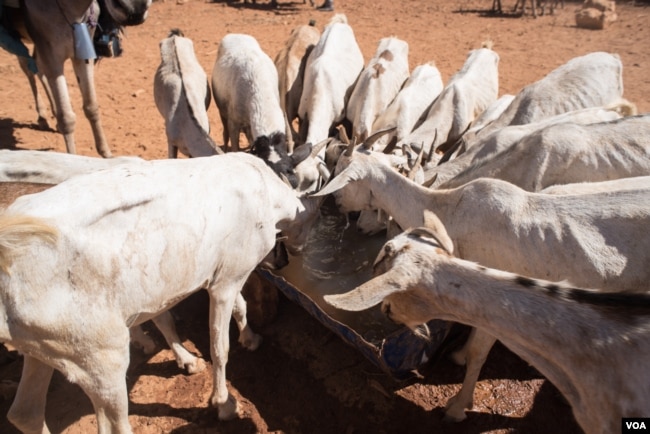
Goats with ribs showing crowd around a a trough of well water in Somaliland region of Somalia, which is experiencing a devastating drought
Herders wait for water trucks
If April's rains fail again, the people who have depended on these animals for generations may be next. The United Nations warns of famine, and says more than 6 million people need food aid already in all of Somalia. Forty have died so far in Somaliland, according to the National Drought Committee. Those seeking respite from the drought trek for days to towns in hopes of finding food and water. Aid agencies and the government send water trucks to fill dried out wells, and each morning, dozens of herders with hundreds of thirsty animals flock to the wells but the reach of the trucks is limited.
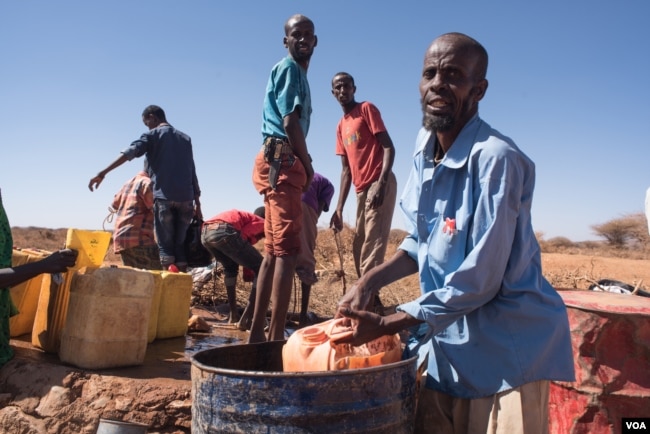
Mohamed Ibrahim Yassin scoops well water from a barrel to feed his remaining livestock in Somaliland region of Somalia
Rains must come
Mohamud Ibrahim Yassin says only a few dozen of his 150 animals made the 20-kilometer walk to one well a few hours east of Burao town. He says the rest were too weak to walk, but too skinny to sell. "If we get rains, they will survive, but if there is no rain, I don't think they will survive," he said. Although Yassin has some hope of getting himself through the drought, for others, the rains will be too late.
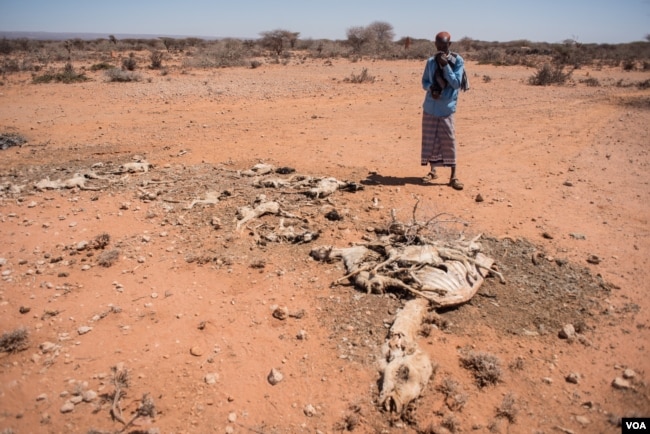
Mohamed Aden Guleid looks at one of his camels which succumbed to drought in Somaliland region of Somalia
Living on handouts
The family of Geelo Ismail Mohamed lost all 100 of their camels over the past seven months, and fled the hinterlands. Now they live on the outskirts of a village in a makeshift hut of wooden poles and scraps of cloth. “We thought that it would get better in two or three months,” said Mohamed, who is in her 70s. “After three months, we realized we couldn't do anything; we couldn't move, we couldn't sell, so we came here.” She says they used to support themselves by selling camel milk, but now, they depend entirely on handouts. “That life [before the drought] will not come back, now we have this life, and this is what Allah has for us,” she said. “I did not ever see a drought like this. This is widespread; this is everywhere.”
Not enough funds
The United Nations estimates that half of Somalia’s population, or 6.2 million people, are threatened by the drought, which is spreading from the hard-hit northern regions. Over the past week, representatives from the World Food Program and the U.N. Children’s Fund, visited some of the worst affected areas in the northern Puntland region.
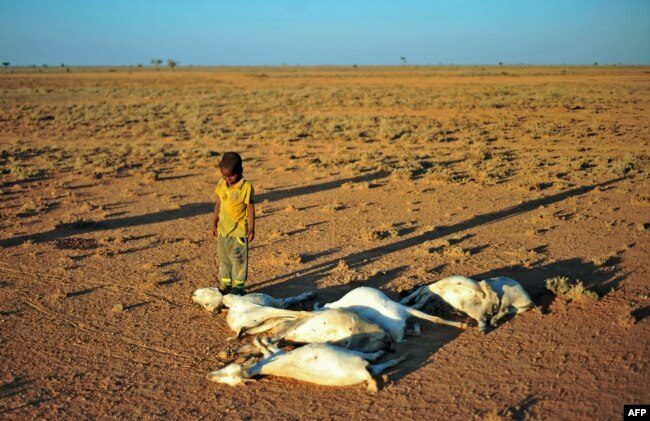
A boy looks at dead goat carcases in dried-out land close to Dhahar in Puntland, northeastern Somalia, on Dec. 15, 2016. Drought in the region has severely affected livestock of local herdsmen.
They describe scenes of utter devastation, where people have reached the limit of their abilities to cope. In one village, the team found about 500 women and children living in precarious conditions in makeshift huts with little inside and surrounded by dead livestock. “Although these are pastoralists,” said Laurent Bukera, WFP country director, "they had for the whole village one goat and one camel that did not look in good shape." “That is an area where normally pastoralists have hundreds of sheep and large swaths of camels.” He said the men had left the village, moving around in search of grazing land and water for the cattle that were still alive.
Short window of opportunity
Speaking on a telephone line from Nairobi, Bukera told VOA that there was a short window of opportunity for aid agencies to scale up emergency operations and prevent the worst from happening. "The severity, the spread of the drought and of the situation this time around is bigger, is larger geographically than what happened in 2010-11." “Therefore, if we do not respond fast enough, if we do not respond at scale,” he said, “we can prepare ourselves for a catastrophe, which is at least to the size and the intensity of the situation we experienced over there in 2010-11.” Nearly 260,000 people, half of them children under five, died during the famine in Somalia between 2010 and 2012. UNICEF projects the number of severely malnourished children in Somalia could reach 270,000 over the coming months.
UNICEF warned that children are among the worst affected by the current drought and that many, once again, are at great risk of dying from malnutrition-related causes. The agency noted that 944,000 children would likely become acutely malnourished this year, including 185,000 severely malnourished. UNICEF spokesman Christophe Boulierac said “these children will need urgent lifesaving support. It is very likely that the number of children severely malnourished will increase 50 percent to 270,000.” He said that by April, 4.5 million people will need water, sanitation and hygiene assistance and that “four million people will be without health services due to the planned closure of health centers due to a funding shortfall.”
$450 million needed

Six-point-two million people in Somalia — half the population — are in need of humanitarian assistance, according to the U.N. To highlight the crisis, U.N. Secretary-General Antonio Guterres, who had been visiting Kenya, made an impromptu change of plans and traveled to Somalia. There he met with President Mohamed Abdullahi Mohamed, known as Farmajo, and visited a local hospital where malnourished people are receiving treatment.
The U.N. director of information in Geneva, Alessandra Vellucci, says Guterres considers it vital that he, personally, address this life-altering crisis. “He decided to go on an emergency visit to Mogadishu, to Somalia in order to focus on famine and cholera. He [Guterres] said in a tweet this morning, people are dying. The world must act now to stop this,” said Vellucci. U.N. emergency relief coordinator Stephen O’Brien arrived Monday.
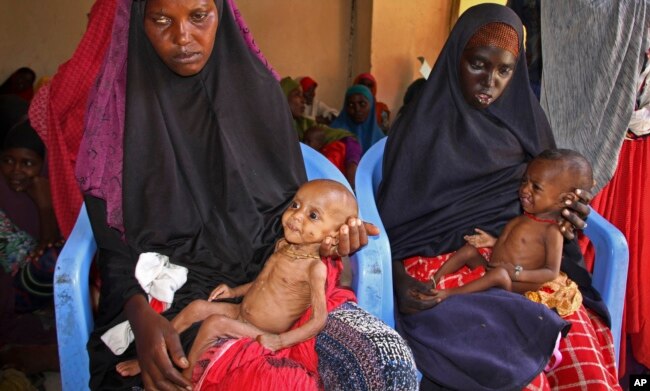
Malnourished babies are held by their mothers, both of whom fled the drought in southern Somalia, at a feeding center in a camp in Mogadishu, Somalia
The United Nations reports nearly 3 million people are going hungry and need urgent life-saving relief. It warns that almost 1 million children under the age of 5 will be acutely malnourished this year, including 185,000 who are at risk of dying if they do not receive immediate medical treatment. Over a recent two-day period, Somali officials report 110 people, many of them women and children, died from water-borne diseases as a result of the ongoing drought. Jens Laerke, spokesman for the U.N. Office for the Coordination of Humanitarian Affairs, says there are worrying similarities in some parts of Somalia to the 2011 famine, which killed 260,000 people.
He tells VOA it is hard to predict when this growing catastrophe could turn into a full-blown famine. “It is a creeping disaster. It creeps up on you," he said. "Day by day it gets a little bit worse. So, how much time do we have? Well, if we stopped operations right now today, people would start dying tomorrow. That is one way of looking at it. So, how much time do we have? Very little time.” Laerke says the Somalia appeal has received $100 million in contributions and more in pledges. While that is good, he says it is not good enough as more support is urgently needed.
Aid Agencies Working to Stave Off Catastrophic Famine in Somalia

The land here dried up not long after he arrived, leaving his animals weak from hunger and thirst. "They are now dying one by one," the 30-year-old said, shading his face from the scorching sun. His goats drank water from a plastic barrel and picked dry leaves from plants nearby. "I don't even think these remaining ones will survive in the next two months," Haji said. He left his wife and five children behind on his eight-day trek, fearing they wouldn't survive. Now he wonders about himself. Somalia has declared this drought a national disaster, part of what the United Nations calls the largest humanitarian crisis since the world body was founded in 1945.
An estimated 6 million people in this Horn of Africa nation, or about half the population, need aid amid warnings of a full-blown famine. Two consecutive seasons of poor rainfall, longer in some areas, have caused large-scale crop failures, the U.N. humanitarian agency says. It is not clear how many people, or animals, have died so far. Animals are central to many in Somalia. The United Nations says more than half the population is engaged in the livestock industry. The drought threatens their main sources of nutrition and survival. Many wells have dried up, forcing herders to risk long treks to remote areas. Water prices have spiked, with a single water tanker now going for $150.

Fatima Ali and her children, who fled the drought, sit by their makeshift hut in a camp for the displaced in Qardho in Somalia's semiautonomous northeastern state of Puntland. Somalia has declared the drought a national disaster, part of what the United Nations calls the largest humanitarian crisis since the world body was founded in 1945, and with animals being central to many the drought threatens their main sources of nutrition and survival
The hot wind blows across the vast, barren land and carcasses of animals. "The sad reality of the drought this severe, this long, this enduring is we're starting to see these massive livestock deaths, livestock losses. Fifty, 60, 70 percent of livestock herds dying, which is an enormous hit for these pastoral families," said Richard Trenchard, the U.N. Food and Agriculture Organization representative in Somalia. The mass animal deaths, from hunger and thirst as well as disease, have caused herders to lose "just about everything," Trenchard said, standing beside the carcass of a camel. Even though rains are expected in mid-April, there are fears that effects of a heavy downpour could kill already weakened animals.
With their livestock gone, herders are ending up in camps with shortages of food, medicine and safe drinking water. "Our journey here was so rough. There was no transport or water. We left behind everything. We are here now and we don't have any proper shelter or transport," said Dahiya Ahmed, a 48-year-old mother of eight at a camp in Qardho town. She once herded 200 goats but now has just six. "The few of them that are still alive are too weak and cannot provide us with milk and meat," she said. "They are just still alive but cannot benefit us at all."
MORE